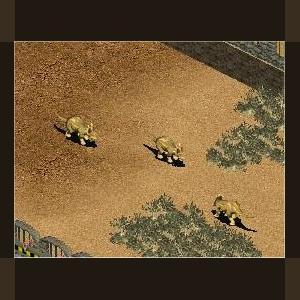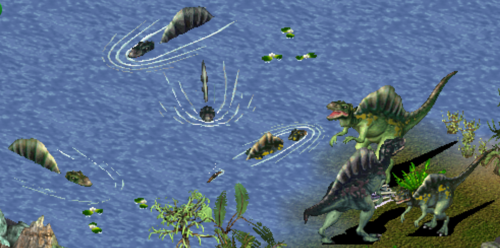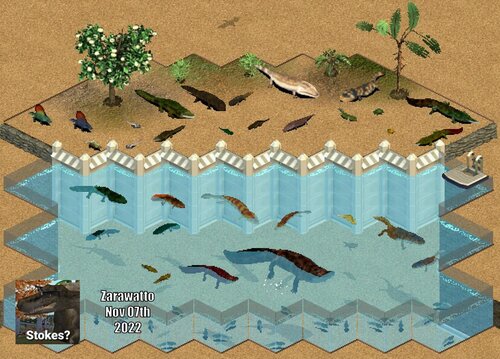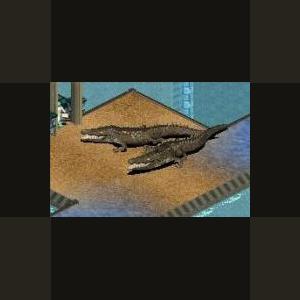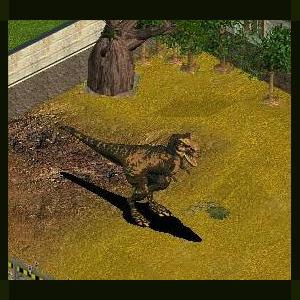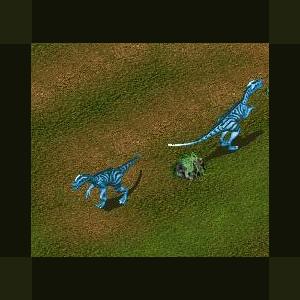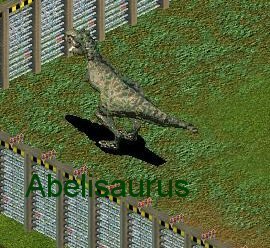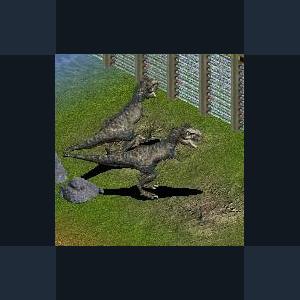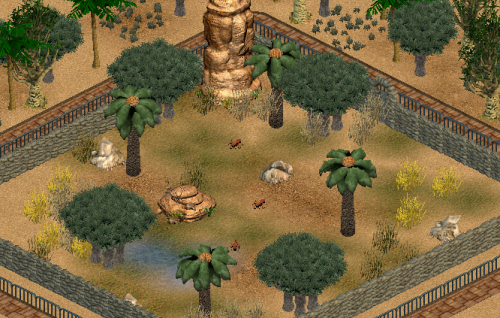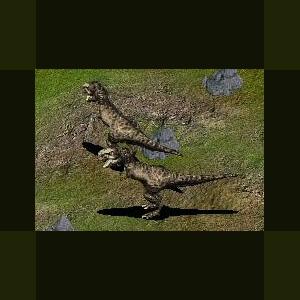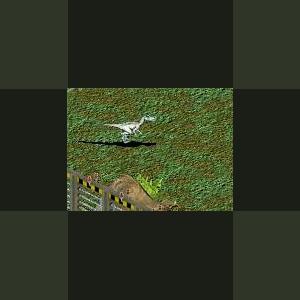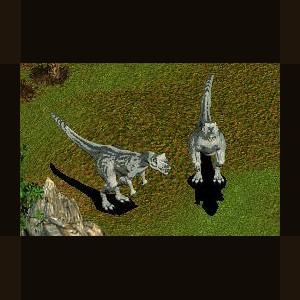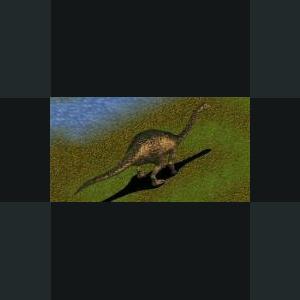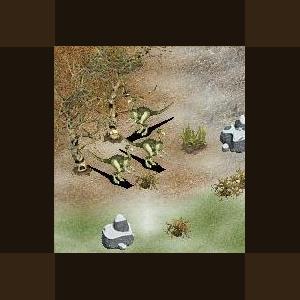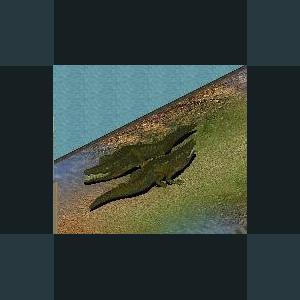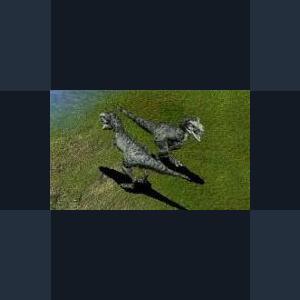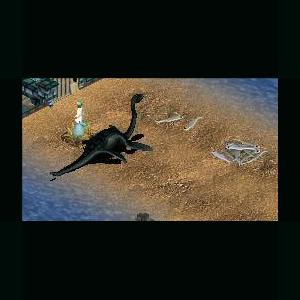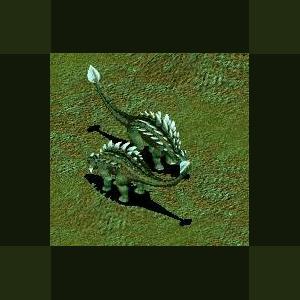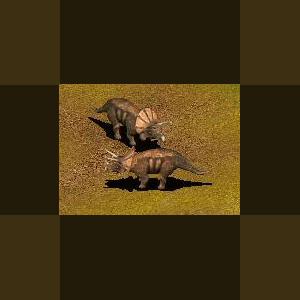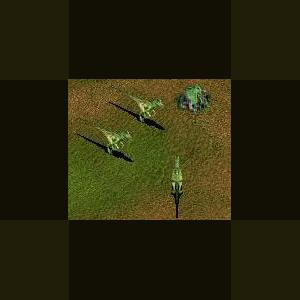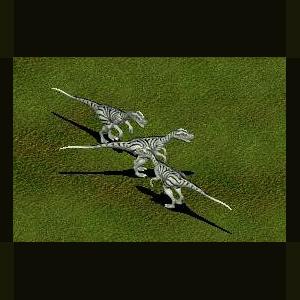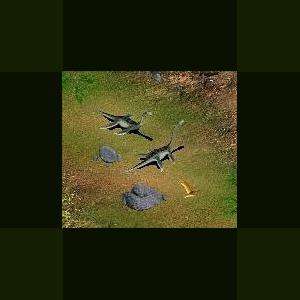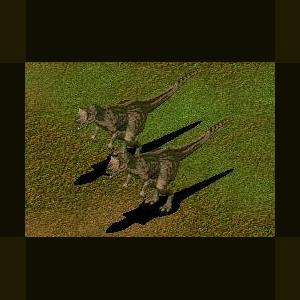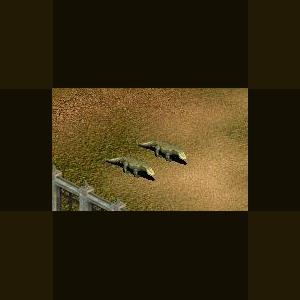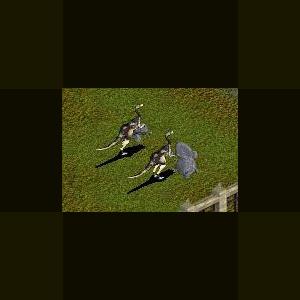Dinosaurs
Creatures from another age
241 files
-
Protoceratops by Ghirin
By Guest
Protoceratops ("Before the horned-faces") is well known from numerous skeletons, ranging from young animals to adults. It was a common dinosaur from Cretaceous Mongolia.
Reference:
The Illustrated Encyclopedia of Dinosaurs by Dougal Dixon. 2006
www.wikipedia.com
Created by Ghirin 2006
504 downloads
Updated
-
Swimming Spinosaurus by Jymn
By Cricket
Would you look at that!
The Spinosaurus at your zoo has finally caught up with modern paleontological consensus and learned to swim. Nice work, guys. They're so happy they've got a derpy new land animation that plays occasionally (made from the fence-zap animation with all the electric shock taken out)
Also they're dimorphic: the ladies are dark crocodile-colours and the babies are dark with yellow spots--like baby crocodiles. The boys just have a slight color change to the inside of the mouth.
Available as a hack or as a new animal. The exhibit requirements are similar to the Combined Realism Hack but you may need to make a few adjustments.
Right now there aren't any 'special' animations in the water like snapping or thrashing. Maybe they'll learn some tricks over the summer...
134 downloads
Updated
-
Toadally Batrocious Land Invaders (Extinct Amphibians Pack)
By Zarawatto
This pack is a Halloween gift for all of you!
~~ IMPORTANT NOTE!!! ~~
Some animals use message texts and images contained in the following files: Borsato's ui99ztd + LANG--ZBorsato.dll in order to see all animal eras in the purchase menu & description window properly. However, even without them, all files should work right.
If you don't have them and wanna know how it works, you may find it here:
https://zootekphoenix.com/forums/topic/11248-borsato-project/page/21/#comment-317858
~~ Content List ~~
Hynerpeton North America. Aquatic. Devonian.
Ichthyostega North America. Aquatic. Devonian.
Proterogyrinus North America. Coniferous Forest. Carboniferous.
Eryops North America. Coniferous Forest. Carboniferous.
Platyhystrix North America. Desert. Permian.
Diploceraspis North America. Desert. Permian.
Uralerpeton Asia. Desert. Permian.
Prionosuchus South America. Coniferous Forest. Permian.
Gerrothorax Europe. Aquatic. Triassic.
Sclerothorax Europe. Aquatic. Triassic.
Metoposaurus Europe. Aquatic. Triassic.
Anaschisma North America. Aquatic. Triassic.
Antarctosuchus Antarctica. Decidous Forest. Triassic.
Mastodonsaurus Eurasia. Aquatic. Triassic.
Siderops Australia. Rainforest. Jurassic.
Beelzebufo Madagascar. Rainforest. Cretaceous.
*Bonus Items*
Tiktaalik North America. Aquatic. Devonian. Early access animal. First release date: Oct 10th, 2022.
-> Tiktaalik previous version must be erased from your /dlupdate folder before installing this pack <-
Swimming Tadpoles Neutral exhibit & tank placeable scenery item!
-> A .txt file with the credits & a compatibility guide.
Enjoy!
184 downloads
Updated
-
Purussaurus by Moondawg
By Guest
Purussaurus was a giant caiman living in South America, 20 million years ago (Miocene). It is only known from skull material found in Peruvian Amazonia.
The skull is about 1.5 meters (5 ft), and paleontologists estimate that the whole body would have measured around 15 meters (50 ft), which means that Purussaurus is one of the largest crocodilians known to have ever existed. Two other extinct crocodilians, Sarcosuchus and Deinosuchus, have similar proportions, but both are geologically much older, dating from the Early and Late Cretaceous, respectively. During the summer of 2005, a franco-peruvian expedition (the Fitzcarrald expedition) found new fossils of Purussaurus in Amazonia (600 km from Lima).
Purussaurus was a giant caiman living in South America during the Miocene epoch, 8 million years ago. It is known from skull material found in the Brazilian, Colombian and Peruvian Amazonia, besides in the north of Venezuela. The skull is about 1.5 meters (5 ft) long, and paleontologists estimate that the whole body would have measured around 12 meters, which means that Purussaurus is one of the largest crocodilians known to have ever existed. Two other extinct crocodilians, Sarcosuchus and Deinosuchus, have similar proportions, but both are geologically much older, dating from the Early and Late Cretaceous, respectively, and another from around the same era, the Rhamphosuchus, is also estimated to be of similar size. During the summer of 2005, a Franco-Peruvian expedition (the Fitzcarrald expedition) found new fossils of Purussaurus in Amazonia (600 km from Lima).
307 downloads
Updated
-
Tarbosaurus by Ghirin
By Guest
Tarbosaurus Author: Ghirin
Tarbosaurus ("Terrible Lizard") was a large tyrannosaurid from the Cretaceous period in Asia. This dinosaur was very similar to the North American Tyrannosaurs rex and some paleontologists consider it to be a species of Tyrannosaur, naming it Tyrannosaurus bataar.
*Inspired by the Zoo Tycoon Brains Trust at the Zoo Tycoon Evolved Forum.*
264 downloads
Submitted
-
Atlascopcosaurus by Moondawg
By Guest
Atlascopcosaurus
Atlascopcosaurus (meaning "Atlas Copco lizard") is the name given to a genus of hypsilophodont dinosaur. It lived in what is now Australia; the type specimen, Atlascopcosaurus loadsi, was found at Dinosaur Cove in Victoria. It was about 2-3 metres (6.5-10 ft) long and weighed roughly 125 kg. It lived during the early Cretaceous (Aptian-Albian), but not much else is known about it; the genus is based on a mostly incomplete skeleton (the holotype consists of a piece of maxilla and teeth).
It was named after the Atlas Copco Company who had provided equipment for the expeditions that discovered this dinosaur in 1984. The project revealed 85 fossil bone fragments. This opened the door for more excavation and, along with other companies, Atlas Copco helped excavate about 60 metres of tunnel over 10 years.
The species name, loadsi, refers to William Loads, the state manager for Atlas Copco at the time, who assisted during the dig.
411 downloads
Updated
-
Abelisaurus by Moondawg
By Savannahjan
Abelisaurus ("Abel's lizard") is a genus of abelisaurid theropod dinosaur from the Late Cretaceous Period of what is now South America.
The generic name recognizes Roberto Abel as the discoverer of the specimen and former director of the provincial Museum of Cipolletti in Argentina, where the specimen is housed. It also incorporates the Greek sauros, meaning 'lizard'. There is one named species, A. comahuensis, which honors the Comahue region of Argentina, where the fossil was found. Both genus and species were named and described by Argentine paleontologists Jose Bonaparte and Fernando Novas in 1985, who placed it in the newly-created family Abelisauridae.
Many other abelisaurids have since been discovered, including extremely complete specimens of Aucasaurus, Carnotaurus and Majungasaurus. Some scientists place Abelisaurus as a basal abelisaurid, outside the subfamily Carnotaurinae. Others are less certain of its position.Abelisaurids share some skull features with the unrelated carcharodontosaurids and, since Abelisaurus is known only from a skull, future discoveries may show that this genus was in fact a carcharodontosaurid. However, this is thought unlikely.
The one known fossil skull of Abelisaurus is incomplete, especially on the right side. It is also missing most of the palate (roof of the mouth). Despite the missing pieces, it is over 85 centimeters (33 inches) long. Although there are no bony crests or horns, like those found in some other abelisaurids, such as Carnotaurus, rough ridges on the snout and above the eyes might have supported some kind of crest made out of keratin, which wouldn't have become fossilized. There are also very large fenestrae (window-like openings) in the skull, which are found in many dinosaurs and reduce skull weight
Abelisaurus is one of the many dinosaurs that have been discovered in Patagonia. It was originally described as coming from the Allen Formation but subsequent research proved the remains were actually found in the older Anacleto Formation (part of the Neuquén Group) of Rio Negro Province, Argentina. The Anacleto is a geologic formation in South America, dating from the early Campanian stage of the Late Cretaceous Period, between 83 and 80 million years ago.
94 downloads
Updated
-
Nanotyrannus by Moondawg
By Guest
Nanotyrannus ("tiny tyrant") is a genus of tyrannosaurid dinosaur, and is possibly a
juvenile specimen of Tyrannosaurus. Represented only by a small skull it was discovered by Charles W. Gilmore in 1942 and described in 1946 as a
specimen of Gorgosaurus lancensis (now known as Albertosaurus).In 1988, the
specimen was re-described by Robert T. Bakker, Phil Currie, and Michael Williams,
the late curator of paleontology at the Cleveland Museum of Natural History, where
the original specimen was housed and is currently on display. Initial research indicated
that the skull bones were fused, and that it therefore represented an adult specimen.
In light of this, Bakker and colleagues assigned the skull to a new genus, which they
named Nanotyrannus for its apparently small size.However, subsequent work has cast
doubt on this, and some paleontologists no longer consider it a valid genus--since the
fossil was a contemporary of Tyrannosaurus rex, many paleontologists now believe it to
be a juvenile T.rex, especially since the discovery in 2001 of new Nanotyrannus specimen,
nicknamed "Jane." The original Nanotyrannus specimen is estimated to have been around
17 feet (5.2 meters) long when it died.
In 2001, a more complete juvenile tyrannosaur ("Jane"),
belonging to the same species as the original Nanotyrannus specimen, was uncovered.
In 2005, a conference on tyrannosaurs focused on the issues of Nanotyrannus validity
brought about by the discovery of the Jane specimen, was held at the Burpee Museum of
Natural History. Several paleontologists, such as Phil Currie and Donald M. Henderson,
saw the discovery of Jane as a confirmation that Nanotyrannus was a juvenile T. rex or
closely related species.Peter Larson, on the other hand, continued to support a
separate genus for Nanotyrannus.The actual scientific study of Jane, set to be
published by Bakker, Larson, and Currie, may help determine whether Nanotyrannus is a
valid genus, whether it simply represents a juvenile T. rex, or whether it is a new
species of a previously identified genus of tyrannosaur.
Bakker has stated he believes Nanotyrannus hunted in packs. Teeth from multiple Nanotyrannus have been found in the bones of herbivorous dinosaurs.
In 2008, Nanotyrannus was featured in the second episode of Jurassic Fight Club, a pseudo-documentary about prehistoric predators.[8] The episode dismissed the ongoing scientific debate on the validity of the Nanotyrannus genus, with the producers preferring instead to present a speculative battle between two juvenile Tyrannosaurus and one Nanotyrannus (which was possibly a juvenile Tyrannosaurus). The episode depicted both genera as having pronated hands (hands with downward or backward-facing palms), something tyrannosaurids could not do.[9] The episode relied heavily on speculation to determine who would be the victor in the battle between the similar (or possibly synonymous) genera. Some television reviewers felt the battles depicted in the series were over-hyped and remarked negatively on the producers and experts' speculation about what the animals were thinking.[10]
190 downloads
Updated
-
Protosolpuga by Serpyderpy
By Serpyderpy
Protosolpuga is an extinct species of solifugae known only from a single specimen that was discovered in Mazon Creek, Illinois, USA. While somewhat bigger than their real life size, these wonderful little creepy crawlies will make a nice addition to your paleozoic zoos!
83 downloads
0 comments
Updated
-
Stokesosaurus by Moondawg
By Guest
Stokesosaurus ("Stokes' lizard") was a small early tyrannosaur from the Late Jurassic period of Utah.
It was named after Utah geologist William Lee Stokes.
The holotype consists of a hip bone, originally thought to belong to the possible early
tyrannosaur Iliosuchus (Galton, 1976), as well as several vertebrae and a partial
braincase (Chure and Madsen, 1998). Another illium referred to this dinosaur (Foster and
Chure, 2000) is lost but may actually belong to the related Aviatyrannis, and a premaxilla
thought to belong to Illiosuchus (Madsen, 1974) is actually from Tanycolagreus.
Stokesosaurus and Tanycolagreus are about the same size, and it is possible that the
latter is a junior synonym of the former. However, the ilium (the best known element of
Stokesosaurus) of Tanycolagreus has never been recovered, making direct comparison
difficult.
Inspired by the Zoo Tek Brains Trust
156 downloads
Updated
-
Utahraptor by Moondawg
By Guest
Utahraptor (meaning "Utah's predator") is the largest known member of the theropod dinosaur family
Dromaeosauridae, and dates from the upper Barremian stage of the Early Cretaceous period (132-119 million years ago).
Like other dromaeosaurids, Utahraptor had a huge curved claw on the second toe that could grow to 23 centimetres (9.1 in) long. The animal may have grasped its prey with its forelimbs while kicking with its hindlimbs. Recent tests on reconstructions of the smaller Velociraptor suggest that claws of this type were used for stabbing or suffocating its prey, not slashing into their hide.Up to 6.5 m (21 ft) long, 2 m (6.6 ft) tall, and 700 kg (1,500 lb) in weight, Utahraptor would have been a formidable predator.
Updated by Cricket on April 5, 2012:
Removed space from name
Removed extra verbiage
348 downloads
Updated
-
Giganotosaurus by Moondawg
By Guest
Giganotosaurus (meaning 'giant southern lizard', derived from the Ancient Greek gigas meaning 'giant', notos meaning 'south wind' and saurus meaning 'lizard') was a genus of carcharodontosaurid dinosaur that lived 93 to 89
Giganotosaurus carolinii was named for Ruben Carolini, an amateur fossil hunter, who discovered the fossils in the deposits of the Rio Limay Formation of Patagonia, southern Argentina, in 1993. It was published by Rodolfo Coria and Leonardo Salgado in the journal Nature in 1995.
The holotype specimen's (MUCPv-Ch1) skeleton was about 70% complete and included the skull, pelvis, leg bones and most of the backbone. It is estimated around 12.2-12.5 m (40-41 ft) in length. A second specimen , 8% larger, has also been recovered. This largest Giganotosaurus specimen is estimated to represent an individual 13.2 m (43.3 ft) long, that weighed 6.2 tons. Giganotosaurus might have had the longest known skull for a theropod dinosaur, with the holotype's skull estimated at 1.80 m (6 ft) and the second specimen's estimated at 1.95 m (6.3 ft).[6] Giganotosaurus surpasses Tyrannosaurus rex in length by almost a meter (the upper length estimate for T. rex is 13 m).
Giganotosaurus, along with relatives like Tyrannotitan, Mapusaurus and Carcharodontosaurus, are members of the carnosaur family Carcharodontosauridae. Both Giganotosaurus and Mapusaurus have been placed in their own subfamily Giganotosaurinae by Coria and Currie in 2006 as more carcharodontosaurid dinosaurs are found and described, allowing interrelationships to be calculated
G. carolinii was slightly larger than T. rex but had a much smaller brain that was the size and shape of a banana. Its teeth were built more for cutting and slicing rather than crushing bones. A well-developed olfactory region means that it probably had a good sense of smell. Its skull, although large, had a slender build.
354 downloads
Updated
-
Rhoetosaurus by Moondawg
By Guest
Rhoetosaurus ("Rhoetos lizard"), named after Rhoetus, a Titan in Greek Mythology, was a genus of Sauropod dinosaur from the Jurassic (Middle Jurassic) of what is now eastern Australia.
Rhoetosaurus is estimated to have been about 12-15 metres long.
In 1924, Heber Longman, self-trained paleontologist at (and later director of) the Queensland Museum in Brisbane, learnt of a large fossil reptile skeleton exposed on Durham Downs Station near Roma in central Queensland. The station manager, Arthur Browne, forwarded fragments of bone to Longman, so and was honoured with the dinosaur's specific name brownei.
The initial collection was of 22 tail vertebrae, including a series of 16 consecutive bones, and other fragmentary hindlimb pieces. Soon after Longman announced the new discovery, he visited the station and arranged for more material of the same skeleton to be sent to the Queensland Museum. These included additional vertebrae from the thoracic area, bits of rib, more caudals and more of the femur and pelvis as well as a cervical vertebra.
Further material was collected by Mary Wade and Alan Bartholomai in 1975, and still more by Drs. Tom Rich, Anne Warren, Zhao Xijin, and Ralph Molnar. This additional material includes more ribs, another possible cervical vertebrae, and most of right hind limb, which is currently under study. To date, the end of the tail, forelimbs nor skull has not been found.
Along with Austrosaurus, Rhoetosaurus is among the two best-known sauropods thus far discovered in Australia, as well as for the Jurassic of Gondwana. Rhoetosaurus is presently the most complete Australian sauropod.
Inspired by the Zoo Tek Brains Trust
75 downloads
Updated
-
Leaellynasaura by Moondawg
By Guest
Leaellynasaura
Leaellynasaura was a small herbivorous ornithopod dinosaur of about 60-90 cm in length from the earliest Cretaceous, first discovered in Dinosaur Cove, Australia.
It was an Australian polar dinosaur. Strangely enough, at this period in time, Victoria would have been well within the Antarctic Circle, which is now very cold. This means that Leaellynasaura was living and apparently thriving much further south than any reptile could today. This is particularly relevant due to Cryolophosaurus being discovered in Antarctica, thus further suggesting the idea that dinosaurs could live under conditions which were once thought unsuitable for their kind. It is possible that the sun would not have risen for several weeks or months in the winter, depending on latitude, which means that Leaellynasaura would have had to live in the dark for perhaps months at a time. This is particularly relevant to the fact that Leaellynosaura had very big eyes and its brain had large optic lobes, as if it had evolved to be routinely active in the dark.Evidence found on the coast of western Victorian coastline suggests that polar dinosaurs, such as Leaellynasaura, may have dug burrows to nurture their young during the polar winter.
Regardless, the fact that it lived in extremely cold temperatures led many scientists to believe that Leaellynasaura was warm-blooded.
No complete skeletons have been found of Leaellynasaura. The species is known from many isolated limb bones, ribs, vertebrae, jaws, teeth and one partial skull.
The type species is Leaellynasaura amicagraphica. It was described in 1989. It was named after Leaellyn Rich, the daughter of the palaeontologist couple Tom Rich and Patricia Vickers-Rich who discovered it. Leaellynasaura was a hypsilophodont, a rather basal ornithopod. Like all ornithopods, it was a herbivore.
307 downloads
Updated
-
DinoCroc by Moondawg
By Guest
DinoCroc
Dinocroc is a 2004 horror film about a prehistoric carnivore, Sarcosuchus imperator. It is resurrected in a genetics laboratory after being mixed with a modern day crocodile, resulting in a hybrid monstrosity that has a lot in common with the Spinosaurus. It escaped the lab in a run-of-the-mill American town, and begins devouring the residents.
304 downloads
Updated
-
Aviatyrannis by Moondawg
By Guest
Aviatyrannis is a genus of tyrannosaurid dinosaur from the Kimmeridgian stage of the Late Jurassic found in Portugal.
It was described by Oliver Rauhut in 2003. The name means "Jurassic grandmother tyrant". It is one of the oldest tyrannosaurs ever found, the oldest being Guanlong (or Iliosuchus if it is indeed tyrannosauroid).
Aviatyrannis was perhaps a contemporary of another ancient tyrannosaur, the American Stokesosaurus. Aviatyrannis was even originally assigned to Stokesosaurus, and its fragmentary remains maintain the question of their synonymity open.
Like other early tyrannosaurs, Aviatyrannis was rather small. The holotype, for example, is an ilium only 90 millimeters long. The type species, Aviatyrannis jurassica, was described by Rauhut in 2003.
Inspired by the Zoo Tek Brains Trust
226 downloads
Updated
-
Hydrotherosaurus by Moondawg
By Guest
Hydrotherosaurus (meaning "water beast lizard") is an extinct genus of elasmosaurid plesiosaur from the Upper Cretaceous (Maastrichtian) of Fresno County, California, measuring up to 13 m in length.
288 downloads
Updated
-
Bissektipelta by Moondawg
By Guest
Bissektipelta is an ankylosaurid dinosaur from the Upper Cretaceous of Uzbekistan. The holotype and only known specimen was collected from the Bissekty Formation (lateTuronian-Coniacian).
The holotype consists of a braincase and incomplete skull roof, along with isolated teeth and osteoderms. Originally, this material was referred to the genus "Amtosaurus", but was reassigned to a new taxon when that genus was declared a nomen dubium. Bissektipelta is presently monospecific, containing only B. archibaldi. The holotype was collected in September of 1998 by the joint Usbek-Russian-British-American-Project. This specimen can be distinguished from "A. magnus" in having three exits for N. hypoglossus instead of two, by the lesser angle between ventral surfaces of basisoccipital and basisphenoid, and by the more caudally situated basispterygoid processes.
420 downloads
Updated
-
Chasmosaurus by Moondawg
By Guest
Chasmosaurus (KAZ-mo-sawr-us) is a ceratopsid dinosaur genus from the Upper Cretaceous Period of North America.
Ceratopsians are split into two subfamilies by taxonomists; those with short frills
(centrosaurines), such as Centrosaurus and those with long frills (chasmosaurines), of
which Chasmosaurus was one. In addition to the larger frill, the long-frilled ceratopsians
typically had longer faces and jaws and it is suggested by some paleontologists that they
were more selective about the plants they ate. Long frills were a relatively late
development in dinosaur evolution, since even Chasmosaurus dates from the late Cretaceous
Period, 76 to 70 million years ago. The frill of Chasmosaurus has been described as
"heart-shaped", since its bone structure consists of two large 'loops' from a central bone.
Some finds include a number of smaller ossifications (called epoccipitals), which may have
grown from the perimeter of the frill. The frill may also have been brightly colored, to
draw attention to its size or as part of mating display. However, the frill was so large
and yet so flimsy (since it was mainly skin stretched between the bones) that it could not
have provided much functional defense. It is possible that it was simply used to appear
imposing or conceivably for thermoregulation. In the event of a chasmosaur herd being
attacked by a predator (such as Tyrannosaurus), the males could have formed a ring and,
with all the frills facing outwards, would have presented a formidable sight.
A drawing of Chasmosaurus.Like many ceratopsians, chasmosaurs had three main facial horns - one on the nose and two on the brow. Different fossil finds have produced inconclusive
results - one species of Chasmosaurus, named C. kaiseni, bore long brow horns, while C. belli had only short ones. Although these were initially named as different species, it now seems possible that the long horns belonged to males and the shorter horns to females.
Interestingly, a Chasmosaurus specimen recovered by Sternberg was accompanied by
fossilized skin.The skin appears to have had many bony knobs (osteoderms) in evenly spaced rows, with five or six sides per knob. Unfortunately, nothing can be learned about the coloration of Chasmosaurus from the known fossil skin samples.
Inspired by the Zoo Tek Brains Trust
238 downloads
Updated
-
Staurikosaurus by Moondawg
By Guest
Staurikosaurus ("Lizard of the Southern Cross") is a genus of early dinosaur from the Late Triassic of Brazil.
There exists only a single specimen of Staurikosaurus, recovered from the Paleontological Site Jazigo Cinco of the Santa Maria Formation in the geopark of paleorrota , Rio Grande do Sul, southern Brazil. The name refers to the star constellation "The Southern Cross", pictured in the coat of arms of Brazil and only visible in the southern hemisphere - when Staurikosaurus was described in 1970, it was unusual to find dinosaurs in the southern hemisphere. It was first described by Edwin Harris Colbert, working at the American Museum of Natural History. The rarity of Staurikosaurus remains may be a result of it being uncommon while alive, or because it lived in an environment like a forest, where fossils rarely form.
Staurikosaurus was a small theropod from the late Triassic Period, 225 million years ago - specifically the Carnian age. It is one of the earliest dinosaurs that is known. At just 2 metres in length (6.5 ft), 80 centimetres tall (31 in), and weighing just 30 kilograms (66 lb), Staurikosaurus was tiny in comparison to later theropods like Megalosaurus. Newer research seems to confirm that Staurikosaurus and the related Eoraptor and Herrerasaurus are definite theropods and evolved after the sauropod line had split from the Theropoda.
There exists very incomplete fossil record of Staurikosaurus, consisting most of the spine, the legs and the large lower jaw. However, dating from such an early period in the dinosaurs' history and being otherwise so primitive, most of Staurikosaurus' other features as being primitive also can be reconstructed. For example, Staurikosaurus is usually depicted with five toes and five fingers - very simple features of an unspecialised dinosaur. However, since the skeletal structure of the legs is known, it can be seen that Staurikosaurus was a quick runner for its size. It also had just two vertebrae joining the pelvis to the spine, a distinctly primitive arrangement. The tail would have been long and thin to balance the border - later sauropods had larger, shorter tails relative to their weight.
The recovered mandible suggests that sliding joint of the jaw allowed it to move backwards and forwards, as well as up and down. Thus smaller prey could be worked backwards towards Staurikosaurus' throat, along its small and backwards-curving teeth. This feature is common in theropods of the time, but disappears in later theropods who presumably had no need for efficiency in eating smaller prey
158 downloads
Updated
-
Ceratosaurus by Moondawg
By Guest
This therapod had a pair of bony ridges above its eyes and a horn on its snout. These were probably used by males when fighting for a mate.
Ceratosaurus (cera-TO-saur-US ) meaning 'horned lizard', in reference to the horn on its nose (Greek keras/keratos meaning 'horn' and sauros meaning 'lizard'), was a large predatory dinosaur from the Late Jurassic Period, found in the Morrison Formation of North America, in Tanzania and Portugal. It was characterized by large jaws with blade-like teeth, a large, blade-like horn on the snout and a pair hornlets over the eyes. The forelimbs were powerfully built but very short. The bones of the sacrum were fused (synsacrum) and the pelvic bones were fused together and to this structure (Sereno 1997) (i.e. similar to modern birds). A row of small osteoderms was present down the middle of the back.
350 downloads
Updated
-
Ceresiosaurus by Moondawg
By Guest
Ceresiosaurus
Ceresiosaurus, meaning "Lizard of Ceres", is an extinct genus of aquatic sauropterygian reptile belonging to the nothosaur order. It was about 4 m (13 ft) long and its fossils have been found in Europe, and was named by Bernhard Peyer in 1931.
Ceresiosaurus existed during the middle Triassic period during the Anisian stage.
Ceresiosaurus was much more elongated than its relatives, and had fully developed flippers with no trace of visible toes. The finger bones in its flippers had multiplied (hyperphalangy) and elongated, giving the reptile much longer flippers than most nothosaurs. Ceresiosaurus's flippers greatly resembled those of the later plesiosaurs, an aquatic reptile family of which the nothosaurs were an early offshoot. Also noteworthy of Ceresiosaurus was that its skull is the shortest known of any nothosaur, giving it an appearance that made it the most plesiosaur-looking of the nothosaurs.
Although possessing a long neck and tail, Ceresiosaurus may not have been a reptile that swam via undulation; analysis of the bone structure in regards to the hips and powerful tail suggest that it instead propelled itself through the water much like a penguin. The evidence of pachypleurosaurs in the preserved stomach of Ceresiosaurus remains lend credence to the theory of it being a fast swimmer.
Olivier Rieppel suggested that Ceresiosaurus is a synonim of Lariosaurus
275 downloads
Updated
-
Carcharodontosaurus by Moondawg
By Guest
Carcharodontosaurus was a gigantic carnivorous carcharodontosaurid dinosaur that lived around 98 to 93 million years ago, during the Cretaceous Period.
It was nearly as long as Tyrannosaurus, growing to an estimated 11.1-13.5 meters (36-44 feet) and weighing up to 2.9 metric tons. The name Carcharodontosaurus means 'shark lizard', after the shark genus Carcharodon (from the Greek karcharo meaning 'jagged' and odonto meaning 'teeth') and sauros, meaning 'lizard'
Carcharodontosaurus was a carnivore, with enormous jaws and long, serrated teeth up to eight inches long. Paleontologists once thought that Carcharodontosaurus had the longest skull of any of the theropod dinosaurs. However, the premaxilla and quadrate bones were missing from the original African skull, which led to misinterpretion of its actual size by researchers. A more modest length of 1.6 meters (5.2 ft) has now been proposed for C. saharicus, and the skull of C. iguidensis is reported to have been slightly larger at 1.75 m in length (5.5 ft). Still, the honor of the largest theropod skull now belongs to another huge carcharodontosaurid dinosaur, the closely related Giganotosaurus (with skull length estimates up to 1.95 m) (6.3 ft).
The Endocranial cast, of the impression of the brain on the inside of the skull, and inner ear anatomy of Carcharodontosaurus saharicus resembled modern Crocodylia.The size of the cerebrum relative to the total brain was similar to modern reptiles, but small relative to coelurosaurian theropods and birds.
Carcharodontosaurus fossils were first found by Charles Depéret and J. Savornin in North Africa in 1927. Originally called Megalosaurus' saharicus(many theropods were once erroneously referred to as Megalosaurus), its name was changed in 1931 by Ernst Stromer von Reichenbach to that used today. Stromer named Carcharodontosaurus "for its mainly Carcharodon-like teeth", which were "not recurved, almost bilaterally symmetrical but with convex edges." These first fossils of Carcharodontosaurus were destroyed during World War II. However, cranial material from a Carcharodontosaurus was again discovered in Morocco in 1996 by paleontologist Paul Sereno. Stephen Brusatte and Paul Sereno reported a second species of Carcharodontosaurus, differing from C. saharicus in some aspects of the maxilla and braincase. This second species, which was discovered in Niger in 1997, was named C. iguidensis in December of 2007.
268 downloads
Updated
-
Baurusuchus by Moondawg
By Guest
Baurusuchus is an extinct genus of baurusuchid mesoeucrocodylian from the Late Cretaceous of South America.
324 downloads
Updated
-
Avimimus by Moondawg
By Guest
Avimimus was a small dinosaur, standing about 45 centimeters (2.5 ft) tall at the hips and
a length of 1.5 m (5 ft). The skull was relatively small compared to the body, though the
brain and eyes were relatively large. The size of the bones which surrounded the brain and
were dedicated to protecting it are large. This is also consistent with the hypothesis
that Avimimus had a proportionally large brain.
As in the related Oviraptoridae and Caenagnathidae, the jaws of Avimimus formed a
parrot-like beak, and lacked teeth. However, a series of toothlike projections along the
tip of the premaxilla would have given the beak a serrated edge. The toothless beak of
Avimimus suggests that it may have been an herbivore or omnivore. Kurzanov himself,
however, believed that Avimimus was an insectivore.
The foramen magnum, the hole allowing the spinal cord to connect with the brain, was
proportionally large in Avimimus. The occipital condyle, however, was small, further
suggestive of the skull's relative lightness.The neck itself was long and slender, and is
composed of vertebrae are much more elongate than in other oviraptorosaurs. Unlike
oviraptorids and caenagnathids, the back vertebrae lack openings for air sacs, suggesting
that Avimimus is more primitive than these animals.
The forelimbs were relatively short. The bones of the hand were fused together, as in
modern birds, and a ridge on the ulna (lower arm bone) was interpreted as an attachment
point for feathers by Kurzanov.Kurzanov, in 1987, also reported the presence of quill
knobs, and while Chiappe confirmed the presence of bumps on the ulna, their function
remained unclear. Kurzanov was so convinced they were attachment points for feathers that
he concluded that Avimimus may have been capable of weak flight. This interpretation has
not seen wide support among paleontologists, however.
The ilium was almost horizontally oriented, resulting in exceptionally broad hips. Little
is known of the tail but the hip suggests that the tail was long. The legs were extremely
long and slender, suggesting that Avimimus was a highly specialized runner. The
proportions of the leg bones add further weight to the idea of Avimimus was quick on its
feet. The animal's shins were long in comparison with its thighs, a trait common among
cursorial animals. It also had three-toed feet with narrow pointed claws.
Its remains were discovered in the Djadokta Formation by Russian paleontologists, and
officially described by Dr. Sergei Kurzanov in 1981. The type species is A. portentosus.
Because no tail was found with the original find, Dr. Kurzanov mistakenly concluded that
Avimimus lacked a tail in life. However, subsequent Avimimus finds containing caudal
vertebrae have confirmed the presence of a tail.
In 1991, Sankar Chatterjee erected the Order Avimimiformes to include Avimimus, though
this group is not used by most paleontologists today as it includes only a single species.
281 downloads
Updated

